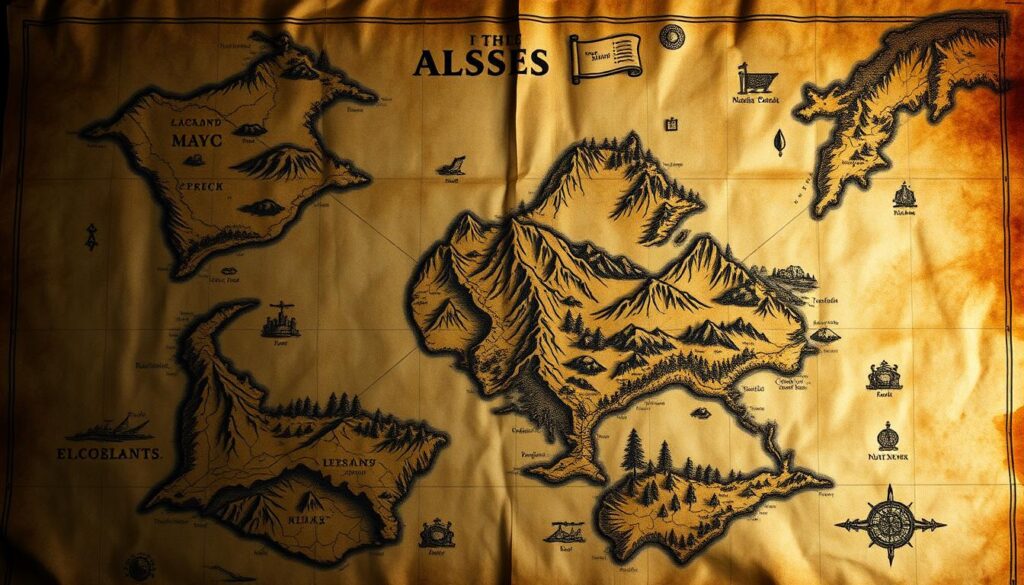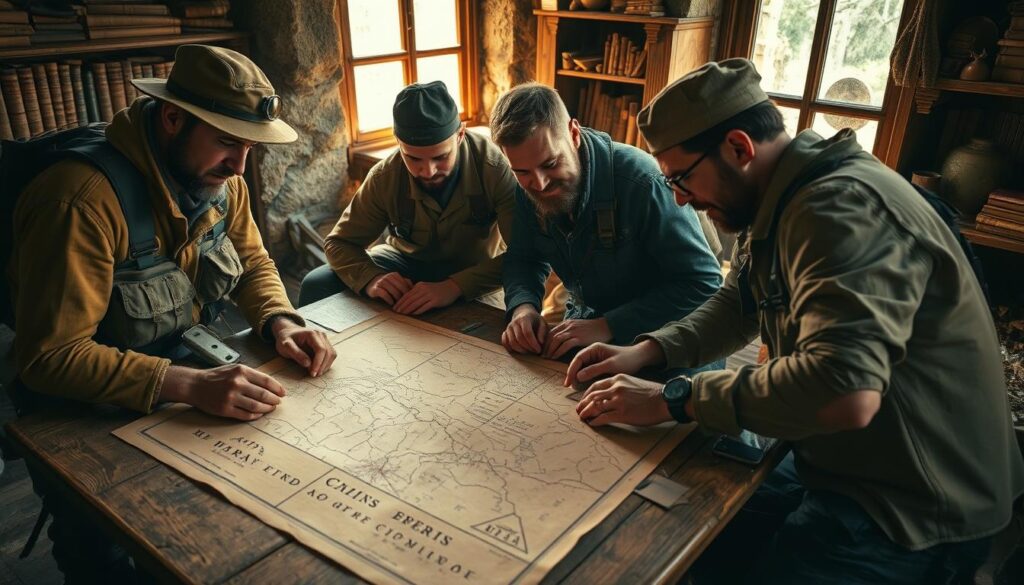The lines on an ancient map whisper tales of forgotten worlds and hidden lands. These maps, with their worn edges and cryptic symbols, have guided explorers for ages. Each mark might reveal a secret to a place yet to be found.

Humans have been drawn to lost lands since we started drawing our world. From Atlantis to the Americas, ancient maps have shown our knowledge and dreams. They mix reality with myth, science with tales.
Even with today’s satellite views, the quest for hidden places goes on. Scholars and adventurers study old maps for clues. They search for lost cities, sunken islands, or vanished civilizations. The excitement of finding a lost land on an ancient map still drives exploration today.
Key Takeaways
- Ancient maps blend geographical knowledge with mythology and imagination
- Historical cartography offers clues to potentially undiscovered lands
- Lost lands have inspired explorers throughout human history
- Modern technology enhances our ability to investigate cartographic mysteries
- Many famous discoveries began with studying unusual markings on old maps
- The search for lost lands continues even in our satellite-mapped world
The Fascinating History of Cartography and Lost Worlds
Maps have shaped our understanding of the world for thousands of years. The practice of historical cartography started with simple clay tablets in Mesopotamia. It evolved into the detailed digital maps we use today. Early mapmakers faced the challenge of representing a vast, largely unexplored world with limited tools and knowledge.
Ancient civilizations approached mapmaking in distinctive ways. The Egyptians created maps focused on the Nile. Greek scholars like Ptolemy attempted to map the entire known world. Chinese cartographers developed sophisticated grid systems, and Maya maps incorporated celestial observations with terrestrial features.
The gaps in geographical knowledge led to fascinating interpretations of unknown territories. Mapmakers filled blank spaces with imaginative elements. Sea serpents marked dangerous waters, and mythical kingdoms were thought to exist beyond explored regions. The famous phrase “here be dragons” captures how unknown lands sparked both fear and wonder.
The relationship between myth and reality in historical geography is intriguing. When explorers encountered the edges of their known world, they often blended observation with cultural beliefs. The legendary island of Thule, described in Greek and Roman cartography, existed at the boundary between documented geography and mythological space.
These early mapping efforts show how human imagination fills in gaps when faced with the unknown. The persistence of lost lands in historical cartography – from Atlantis to Lemuria – demonstrates our enduring fascination with what might lie beyond the horizon.
Famous Ancient Maps That Challenged Our Understanding of Geography
Throughout history, ancient maps have shown us how our ancestors saw the world. The Piri Reis map, made in 1513, is a big mystery. It seems to show Antarctica long before it was found, sparking debates among historians.
The Waldseemüller map of 1507 was the first to call the New World “America.” Made by Martin Waldseemüller, it changed how we see the world. It showed a new western hemisphere, showing how fast Europeans were learning about geography.
Ptolemy’s Geography from the 2nd century CE was a big influence for over a thousand years. It had errors but helped create systems we still use today. It shows how early ideas shaped our view of the world for a long time.
The Fra Mauro map from 1459 was different because it put south at the top. This Venetian map used knowledge from Arab traders. It shows how different cultures helped expand our understanding of the world.
| Map Name | Date Created | Cartographer | Revolutionary Feature |
|---|---|---|---|
| Piri Reis Map | 1513 | Piri Reis | Possible depiction of Antarctica |
| Waldseemüller Map | 1507 | Martin Waldseemüller | First to name “America” |
| Ptolemy’s Geography | ~150 CE | Claudius Ptolemy | First coordinate system |
| Fra Mauro Map | 1459 | Fra Mauro | South-oriented perspective |
Decoding an Ancient Map Leading to an Undiscovered Land
Unlocking ancient maps’ secrets needs science and intuition. These old maps hold clues to hidden lands, if we understand their symbols. Cartographers used symbols and art to share complex information.
Common Symbols and Their Hidden Meanings
Map symbols change with culture and time, each with its own tale. Sea monsters warned of dangers, not real beasts. Swirling patterns near coasts showed strong currents or reefs.
Trees in odd shapes pointed to fertile valleys. Mountains with sharp lines were hard to cross. Soft peaks were easier to pass. Small crosses or temple icons marked sacred places.
Geographical Markers That Signal Potential Lost Territories
Odd landforms on maps hint at hidden lands. Wide rivers indicated resources nearby. Islands near known areas might be real, undiscovered places.
Coastlines with unique shapes or peninsulas are key. They might match unexplored areas. Stars or astronomical signs near land helped find places at certain times.
Authentication Methods for Historical Cartographic Discoveries
Experts check map authenticity in several ways. They analyze paper and ink to find the map’s age. Comparing with other maps from the same time helps spot fakes.
Maps must show accurate geography of known places. Even skilled forgers can’t fake the wear and tear of real maps over time.
Legendary Explorers Who Followed Ancient Maps to Glory or Doom
Explorers have always been drawn to the promise of ancient maps. These maps, full of mystery and sometimes truth, have led to great discoveries and tragic failures. They have driven adventurers to risk everything in search of legendary locations.
Success Stories: When Ancient Maps Proved Accurate
Heinrich Schliemann found Troy in 1873, thanks to Homer’s texts. His work changed archaeology. Hiram Bingham discovered Machu Picchu in 1911, using local stories and maps.
These stories show how ancient maps can lead to real treasures. Percy Fawcett’s work in South America helped later explorers find new places.
Cautionary Tales: The Perils of Misinterpreted Maps
Not all stories end well. Sir John Franklin’s 1845 Arctic expedition ended in disaster. His ships got stuck in ice, and 129 men died.
The search for El Dorado also had many failures. Gonzalo Pizarro lost 4,000 men in the Amazon. They believed in exaggerated stories and bad maps.
Cultural Significance of Lost Lands in Global Mythology
For thousands of years, stories of lost lands have fascinated us. These mythical places show up in many cultures, symbolizing paradise lost or forgotten wisdom. From Atlantis to El Dorado, these legends reflect the dreams and values of ancient societies.
These tales tell us a lot about ourselves. When the Greeks talked about Hyperborea, they were sharing their dreams of a perfect society. Tibetan stories of Shambhala also create a sacred world beyond our own.
In the heart of every seeker lies the dream of an unspoiled realm, a place where the wisdom of ancient civilizations remains preserved against time’s erosion.
What’s so captivating about these lost lands is their place between reality and myth. Sometimes, archaeology backs up these legends, showing they might be based on real events. Stories of Dwarka in India or Helike in Greece started as myths but became real sites after discoveries.
| Mythical Land | Culture of Origin | Key Characteristics |
|---|---|---|
| Atlantis | Greek | Advanced island civilization sunk beneath waves |
| El Dorado | South American | City of gold hidden in jungle |
| Shambhala | Tibetan | Mystical kingdom concealed in mountains |
Modern Expeditions Chasing Historical Cartographic Clues
The search for ancient map secrets is still exciting today. Explorers use old maps and new tech to find hidden treasures and lost cities.

Contemporary Discoveries Guided by Ancient Wisdom
Recently, explorers found a 15th-century Spanish galleon off Colombia’s coast. They used old nautical charts to find it. In Cambodia, archaeologists found temple ruins by using ancient texts and colonial maps.
Ongoing Searches for Legendary Locations
Teams are searching for places mentioned in old documents. In Brazil’s Amazon, they follow Portuguese maps to find Z. Underwater explorers in the Caribbean look for pirate ships with museum maps.
Funding and Organizing a Map-Based Expedition
Planning an expedition needs careful planning. They get money from grants, sponsors, and crowdfunding. A good team has cartographers, guides, and tech experts.
Getting permission from governments and local groups is key. It shows respect for the places they explore.
“Maps don’t just show where to go—they tell stories about who we were and connect us to forgotten chapters of human achievement. Each expedition brings us closer to understanding our shared past.”
Technological Tools Revolutionizing the Search for Unmapped Territories
The search for unmapped territories has changed a lot with new technology. Explorers now use advanced tools, not just compasses and paper maps. These tools show us landscapes we couldn’t see before.
Satellite imaging has changed how we explore maps. It showed an ancient Mayan city in Guatemala’s jungle. Satellites found patterns under the jungle that matched old maps.
LIDAR technology looks through forests to find hidden features. In Cambodia, it found big cities around Angkor Wat. This confirmed old Chinese maps.
Now, we can map the ocean floor with great detail. In the Baltic Sea, we found shipwrecks where old maps said they were. This shows how good early mapmakers were.
- Ground-penetrating radar locates structures beneath the earth’s surface
- Drone surveying captures detailed imagery of inaccessible areas
- 3D modeling software reconstructs ancient landscapes from fragmentary data
- AI analysis identifies patterns humans might miss in historical maps
| Traditional Method | Modern Technology | Exploration Impact |
|---|---|---|
| Compass navigation | GPS positioning | Precision increased by 1000x |
| Hand-drawn maps | Satellite imaging | Complete coverage of unmapped territories |
| Visual observation | LIDAR scanning | Reveals features invisible to human eye |
| Excavation | Ground-penetrating radar | Non-destructive cartographic discoveries |
Personal Stories: Amateur Explorers Who Found Remarkable Places Using Old Maps
Map exploration is now open to everyone, not just experts. People with old maps, metal detectors, and curiosity have found amazing things. These discoveries have changed how we see history.
Sarah Parcak started with a love for maps. She found a Viking settlement in Newfoundland using old maps and satellite images. Her journey began in her garage, where she studied maps from estate sales.

Citizen Archaeologists Making Significant Contributions
In rural England, James Richardson, a retired postal worker, found a Roman villa with a 17th-century map. The map showed a strange structure that experts had missed. With permission, he found mosaic floors and artifacts in the county museum.
In America, metal detectorists have found Revolutionary War sites and Native American paths. They used maps from the colonial era to make these discoveries.
Building Communities Around Historical Map Exploration
These finds have grown communities of map explorers. Online groups like HistoricMapQuest have over 50,000 members. They share maps, tips, and discoveries.
Weekend workshops teach people about old maps and how to explore responsibly. Local historical groups also work with amateurs. Together, they’ve found many new sites, showing that passion can lead to discovery.
Planning Your Own Quest: Resources for Aspiring Cartographic Adventurers
Starting your journey into cartographic adventures needs preparation and knowledge. The excitement of following ancient maps to archaeological discoveries begins with mastering basic skills and gathering the right resources.
Essential Skills for Map-Based Exploration
Basic navigation skills are key to successful expedition planning. Learn to read topographical features, understand coordinate systems, and use a compass correctly. Research skills are also crucial—knowing how to access historical archives, verify map authenticity, and connect cartographic clues with geographical landmarks can turn a casual outing into a meaningful exploration.
Ethical Considerations When Pursuing Unmapped Territories
Respect is essential in cartographic adventures. Get permits before exploring protected lands, and never remove artifacts from archaeological discoveries. When your expedition planning involves culturally significant areas, contact local historical societies or indigenous communities. Remember, preservation is more important than personal achievement.
Documentation Practices for Your Discoveries
Proper documentation makes amateur exploration valuable research. Record exact GPS coordinates, take photos from multiple angles with scale references, and keep detailed field notes. Use digital mapping tools to create maps of your findings, which help visualize connections between sites. Share your documented cartographic adventures through established platforms where experts can verify and build upon your work.
Many universities offer free online courses in basic archaeology and cartography—perfect for beginners. The Explorer’s Network and Historical Mapping Society provide forums where beginners can connect with experienced adventurers for guidance on responsible expedition planning.
Conclusion: The Enduring Allure of Ancient Maps and Undiscovered Lands
Ancient maps and the idea of undiscovered lands still excite many. They have been a source of wonder for centuries. This fascination drives us to explore and learn more about our world.
Exploring these lands is not just about finding new places. It’s about understanding our world better. From the old days of sailing to today’s space travel, we keep seeking answers. Ancient maps hold secrets that can guide us in this quest.
When you start your own journey, you join a long line of explorers. Your maps, whether real or in your mind, tell stories of our world. Let your dreams take you to new places, inspired by the magic of ancient maps.
FAQ
What are the early mapping techniques and their limitations?
Ancient civilizations like the Egyptians, Greeks, Chinese, and Mayans used early mapping techniques. These methods were limited by the technology of their time. They relied on visual observations and simple tools, leading to maps that were sometimes wrong or distorted.
How did ancient civilizations conceptualize unknown territories?
Ancient civilizations filled unknown territories with myths and warnings. They mixed real observations with cultural beliefs. This created maps that showed unknown lands in fantastical ways.
What are some famous ancient maps that challenged our understanding of geography?
Maps like the Piri Reis and Waldseemüller maps showed lands that were new to their time. They challenged old ideas about the world. Maps by Ptolemy and Fra Mauro also showed new things, changing our view of geography.
What common symbols and hidden meanings can be found in ancient maps?
Ancient maps used symbols and markers with hidden meanings. These clues could point to lost places. By studying these symbols, we learn about the creators’ worldviews.
What are some success stories of explorers who followed ancient maps to make remarkable discoveries?
Explorers like Heinrich Schliemann and Hiram Bingham found famous places using old maps. Percy Fawcett’s search for Z is another example. These stories show how ancient maps can lead to big discoveries.
How have modern technologies revolutionized the search for unmapped territories?
New technologies like satellite imaging and drones have changed how we find new places. These tools help us check if old maps were right. They also give us new insights into history.
What essential skills are needed for map-based exploration?
Map-based explorers need skills like map reading and navigation. They also need to know how to research and document. It’s important to respect cultures and follow laws when exploring.
